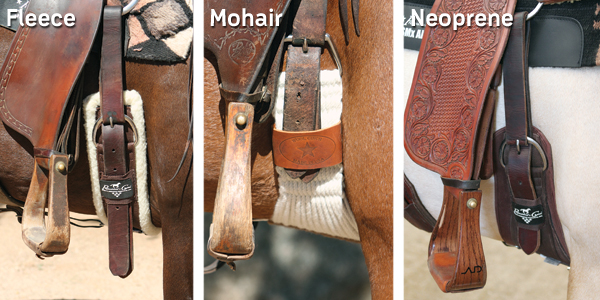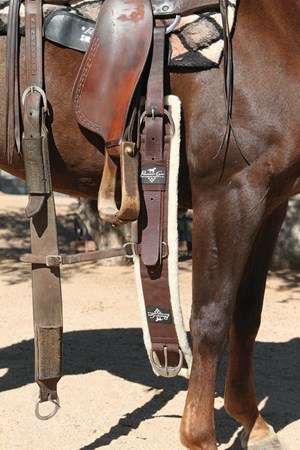The front cinch is a necessary fixture of any Western saddle; without it, your saddle won’t stay on. With the help of adjustable leather or nylon straps, or latigos, your cinch holds the saddle in place and withstands the repeated force behind a horse’s movements. Its safety factor is critical, because a broken or poorly fitted front cinch can easily spell a wreck. Here’s how to choose and fit your front cinch wisely.
[READ: No More Saddle-Sore]
Materials
The three most common materials for cinches are fleece, mohair, and neoprene, all of which have pros, cons, and appropriate uses.

Fleece. This is the softest against the horse’s skin. If it’s not well cared for, however, it’s most likely to clump and mat, which will make it uncomfortable. There’s more slip to this material than others, which means you must tighten it more against your horse’s girth area to hold your saddle in place. It’s also dense, so your horse could miss cues if you contact the cinch instead of him.
Mohair. This is the most traditional and breathable. Mohair breathes and dries better than fleece, which makes it easier to maintain because it doesn’t retain moisture. It’s not as easy to clean as some of the other options, so may not be the best time-saving variation.
Neoprene. It has more grip than other materials, and it’s easy to clean. It dries quickly so can be sprayed directly with anti-fungal solution and disinfectant, making it easiest to maintain. However, neoprene can get too hot and scald the skin on sensitive horses. In these cases, look for a neoprene cinch that has built-in, breathable holes that allow heat to dissipate.
[READ: Desensitize to Cinch Pressure]
Sizing
Western cinches are typically sized in 2-inch increments, between 26 and 34 inches. To measure, place an unrigged saddle on your horse’s back. With the help of a friend, place a soft measuring tape beneath the girth area to measure between the saddle’s dee rings. To determine cinch size, subtract 6 to 8 inches from the total; for instance, if your tape shows 40 inches between dee rings, proper cinch size will be 32 or 34. Err on the smaller size so you can make adjustments before you mount up and don’t run out of holes in your latigos.
Care
Front cinches need regular cleaning for maintenance. Built-up sweat, hair, mud, and moisture will damage equipment over time and predispose your horse to skin conditions, such as girth itch. Allow your cinch to dry completely after a sweaty session, or spray down before you store it. Caked hair or dirt means it’s time for a thorough cleaning.
Strip your fleece cinch and throw it into the washing machine. Brush it after it’s dry, and it’ll be back to near-new condition.
Hand-wash mohair. The hardware could damage your machine. Use mild soap and water and rinse thoroughly.
Neoprene is the easiest to clean. It can be rinsed with a hose, sprayed with disinfectant, and then left to dry. It also can be stripped from the saddle and washed, like fleece.
Styles
Cinch style depends on your riding purpose, your personal preference, and the best fit for your horse.
Straight. This is the most common style, and most appropriate for the majority of riders. (See “Fleece” photo on page 38.) It can be used in most disciplines and for general riding, and is often the most cost-effective.
Roper. This style widens through the middle of the cinch (see “Mohair” photo on page 38), providing more surface area for the saddle to secure. Though it’s called the roper, it’s used in non-roping, high-performance riding, too. It also provides security for horses with low withers to keep your saddle from rolling.
Contoured. This style tapers, or cuts back, near the horse’s armpits, which helps prevent chaffing. Contoured cinches are especially helpful in events that require a broad range of motion, such as Western dressage or trail challenges.
Double-layer. These are just as the name suggests, double layered (typically with mohair). The additional layer adds extra support to material and is typically made in a tapered, roper style.
[READ: Cinch Up Your Saddle Right]
Longevity
A well-cared-for cinch will last. Visible fraying, matting, or cracking (such as with neoprene), or if hardware is damaged, means it’s time to replace it. Check your cinch often for general wear and replace accordingly. Damage occurs from poor maintenance over time or from spurs or snags on the trail, so is mostly preventable.

It might seem expensive to replace your cinch that looks “alright,” but the money saved is not worth the safety expense. If the front cinch breaks during a ride and you injure yourself or your horse, you’ll wish you’d replaced it sooner. This applies to latigos as well. Check them regularly to make sure they’re in good repair.
Extra
Every front cinch has two smaller dee rings on each side of the center of the girth. The front-facing dee is for attaching the breastcollar. Cinch up with equal space between the cinch and saddle on both sides of your setup. The dee should be centered, rather than snugged up between your horse’s girth and his shoulder—ouch!
The back-facing dee is for your back cinch hobble. A hobble keeps the back cinch (if you have one) in place, so it doesn’t slip to sensitive areas, such as the flank.
Al Dunning, Scottsdale, Arizona, has produced world champion horses and riders in multiple disciplines. He’s been a professional trainer for more than 40 years, and his expertise has led him to produce books, DVDs, and his own online mentoring program, Team AD International (teamadinternational.com).




